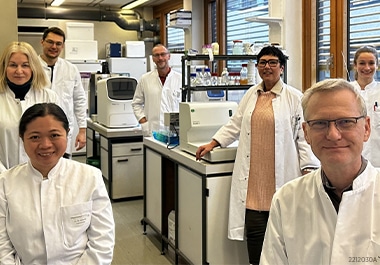Opening the Barriers in Glioblastoma with Tumor Treating Fields

Treatment options for brain cancers, including aggressive glioblastoma, are limited despite the availability of several chemotherapeutic drugs due to the inability of these drugs to cross the blood-brain barrier (BBB). AACR-Novocure grantee Dr. Carsten Hagemann and his team showed that the use of low-intensity alternating electric fields known as Tumor Treating Fields (TTFields), an FDA-approved treatment modality, can facilitate drugs crossing the BBB. Using multiple models, they elucidated the mechanisms driving this action.
They recently published two manuscripts: one in Biomolecules (1) and the other in Pharmaceutics (2). Their findings may potentially be translated into the clinic to treat not only glioblastoma, but other central nervous system diseases as well.
The BBB restricts access to the brain by virtue of its low paracellular permeability, which can be measured as transendothelial resistance (TEER) (3). Using in vitro and in vivo models, Dr. Hagemann and his team showed that TTFields can transiently and reversibly increase BBB permeability and reduce TEER. They further showed that treating a glioblastoma animal model with TTFields prior to treatment with paclitaxel, a drug usually not able to pass the BBB, resulted in a significant reduction in tumor volume compared to treatment with paclitaxel alone.
BBB integrity is dependent at least in part to the function of tight junction proteins between the brain endothelial cells, including cytoplasmic adaptor proteins (e.g., zonula occludens-1, ZO-1), integral membrane linker proteins (e.g., occludin and claudins), and adherens junction proteins such as PECAM-1 (4, 5). Immunofluorescence studies in murine cerebellum-derived microvascular endothelial cells showed that claudin-5 and ZO-1, which are typically located at the boundaries of endothelial cells, were delocalized as a result of TTFields treatment. A similar delocalization of claudin-5 and PECAM-1 was observed in brain cryosections from TTFields-treated rats. Given that the Rho-associated protein kinase (ROCK)-mediated phosphorylation of claudin-5 at T207 has been shown to destabilize claudin-5 at the plasma membrane, the authors confirmed that TTFields induced claudin-5 phosphorylation. Further, they demonstrated that the TTFields-induced delocalization of claudin-5 was dependent at least in part to ROCK activity.

Dr. Carsten Hagemann, Professor for Experimental Neurosurgery and head of the Section Experimental Neurosurgery within the Department of Neurosurgery, University Hospital Würzburg, and the lead author of the study received the AACR-Novocure Tumor Treating Fields Research Grant in 2020. He lauded that the research supported, at least in part, by the grant has increased the visibility of his research program. In addition, he cited how the grant has paved the way for new international collaborations, “I am very grateful for how AACR grant support furthered both the research of my team and my career as the lead PI.”
References:
- Salvador E, Kessler AF, Domröse D, Hörmann J, Schaeffer C, Giniunaite A, et al. Biomolecules 2022; 12: 1348
- Salvador E, Köppl T, Hörmann J, Schönhärl S, Bugaeva P, Kessler AF, Burek M, et al. Pharmaceutics 2023; 15: 185
- Vigh JO, Kincses A, Ozgur B, Walter FR, Santa-Maria AR, Valkai S, et al. Micromachines (Basel) 2021; 12: 685
- Knox EG, Aburto MR, Clarke G, Cryan JF, O’Driscoll CM. Molecular Psychiatry 2022; 27: 2659–2673
- Cummins PM. Mol Cell Biol 2012; 32: 242–250